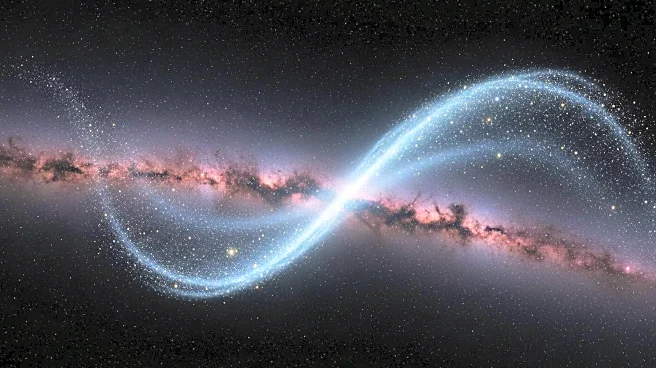What's Happening?
Astronomers have identified a 'Great Wave' propagating through the Milky Way's outskirts, using data from the European Space Agency's Gaia mission. The study, led by Eloisa Poggio from the Astrophysical Observatory of Torino, Italy, analyzed the positions and velocities of 20,000 massive young stars. These stars, located between 30,000 and 45,000 light-years from the galactic center, exhibit vertical motions beyond what is expected from the galaxy's warped disk. The wave-like behavior of these stars suggests a significant event in the galaxy's past, possibly a collision with a dwarf galaxy. The findings, published in Astronomy & Astrophysics, provide new insights into the dynamic nature of the Milky Way.
Why It's Important?
The discovery of the 'Great Wave' offers crucial insights into the Milky Way's history and structure. Understanding these stellar movements can help astronomers piece together past galactic events, such as collisions with other galaxies. This knowledge is vital for comprehending the evolution of our galaxy and its future trajectory. The study also highlights the capabilities of the Gaia mission in mapping and analyzing stellar data, which is essential for advancing astrophysical research. The implications extend to broader cosmic phenomena, potentially influencing theories on galaxy formation and interaction.
What's Next?
Future research will focus on identifying the exact cause of the 'Great Wave' and its connection to other galactic structures, such as the Radcliffe Wave. Upcoming Gaia data releases and improved computer simulations will aid astronomers in exploring these phenomena further. Additionally, researchers will continue to investigate the potential impact of past galactic collisions on the Milky Way's current dynamics. These efforts will enhance our understanding of the galaxy's evolution and contribute to the broader field of astrophysics.
Beyond the Headlines
The study raises questions about the interconnectedness of galactic structures and the role of external forces in shaping the Milky Way. The potential involvement of dwarf galaxies in creating these waves suggests a complex interplay between different cosmic entities. This research may lead to a reevaluation of existing models of galaxy formation and interaction, emphasizing the importance of external influences in galactic evolution.











